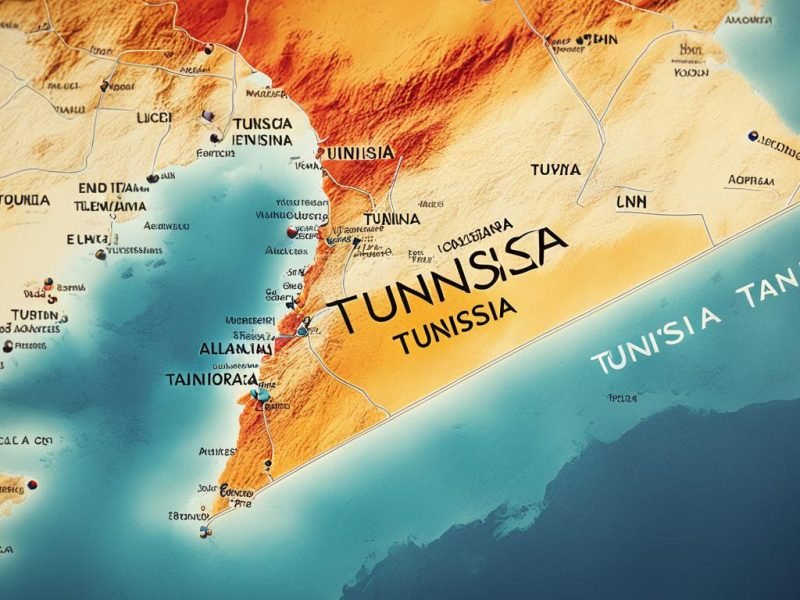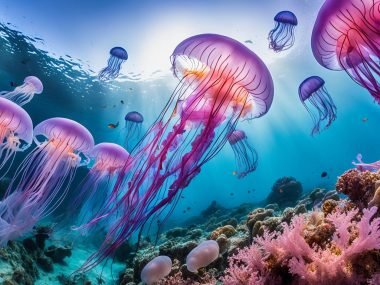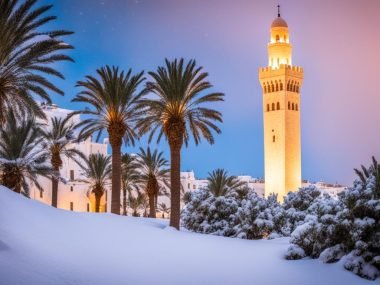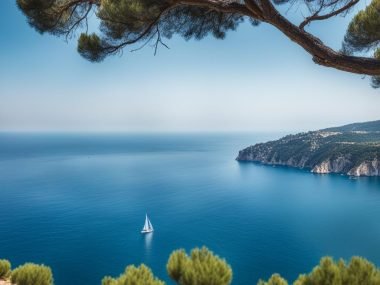Did you know Tunisia is North Africa’s smallest country? Yet, it has a long coastline along the Mediterranean Sea, over 1,300 kilometres long. This place is special because of its location and beautiful sea views. Many people from different parts of the world have come to Tunisia. They came because of its beauty and its important place on the map.
Tunisia’s special spot in North Africa is known for more than just its location. It’s also famous for its mix of cultures and its history. The capital city, Tunis, shows off both the old and new parts of Tunisia. It’s a place where history and today meet.
Looking at a map or walking through Tunisia, you see a land filled with stories. It connects different cultures and times. Now, we’re going to learn more about Tunisia’s special place in North Africa.
Key Takeaways
- Tunisia is the smallest nation in North Africa, yet boasts a 1,300-kilometre Mediterranean Sea coastline.
- The country’s strategic location has made it a crossroads of civilisation throughout history.
- Tunisia’s Mediterranean Sea coastline has attracted conquerors and visitors for centuries.
- The capital city, Tunis, exemplifies a blend of ancient and modern influences.
- Tunisia’s geography represents a compelling intersection of different cultures and historical periods.
Introduction to Tunisia
Where is Tunisia? It’s in Northern Africa, bordered by the sea. This special spot makes it a bridge between Africa and Europe. Thus, its culture is rich and diverse.
Algeria is to its west, Libya to the southeast. These neighbours shape its culture too. The land has beautiful coasts, plains, and mountains. They make Tunisia visually stunning.
Tunis is Tunisia’s capital. It’s the political and economic centre. It also leads in culture, showing off modern Tunisia. Since 1956, when it got independence, Tunisia has seen big changes. The Jasmine Revolution in 2011 was a major one.
Wondering where Tunisia is? Its location has brought together many cultures. Its people are known for being warm and kind. This comes from centuries of meeting different people.
In short, Tunisia’s place in North Africa and by the sea is key to its identity. Its landscapes, capital Tunis, and neighbours shape this fascinating country.
Geographic Location of Tunisia
Tunisia is a lively country in North Africa. Its place on the map is key. It’s near the Mediterranean, which has helped its trade and modern ties.
Coordinates and Borders
Tunisia is between 37° and 30° N, and 7° and 12° E. It has Algeria to the west and Libya to the south-east. A long coastline with the Mediterranean is to the north and east. This spot is vital for its role in North Africa.
Neighbouring Countries
Tunisia has borders with important North African countries. Algeria is on the west, and Libya is to the south-east. Being next to these countries is key for regional talks. Tunisia links the Arabic and Western worlds.
Strategic Position in North Africa
Tunisia is at a key point in North Africa. It is where the eastern and western Mediterranean meet. This makes it very important for sea travel and trade. It also has a sea border with Italy. This makes it a bridge between Europe and North Africa.
| Feature | Detail |
|---|---|
| Latitude | 37° – 30° N |
| Longitude | 7° – 12° E |
| Western Border | Algeria |
| South-Eastern Border | Libya |
| Maritime Border | Italy |
Tunisian Geography and Landscape
Tunisia’s geography is rich and varied. It has mountains, plains, valleys, and a big coastline along the Mediterranean Sea. This mix is key for its importance and wealth. Let’s explore what makes the Tunisian landscape special.
Mountain Ranges
Most of the Tunisian mountains are part of the Atlas Mountains. They stretch across North Africa. You’ll find Jebel ech Chambi, Tunisia’s tallest peak, among others here. These areas are full of life and very important for nature.
Major Plains and Valleys
Tunisia has many big plains and fertile valleys. The Majardah River Valley is a key farming area. It helps Tunisia’s economy a lot. The eastern coastal plains are famous for growing olives. This makes Tunisia one of the top olive oil makers. The south turns into the Sahara Desert, showing a big change from the green lands in the north.
Coastline and Maritime Claims
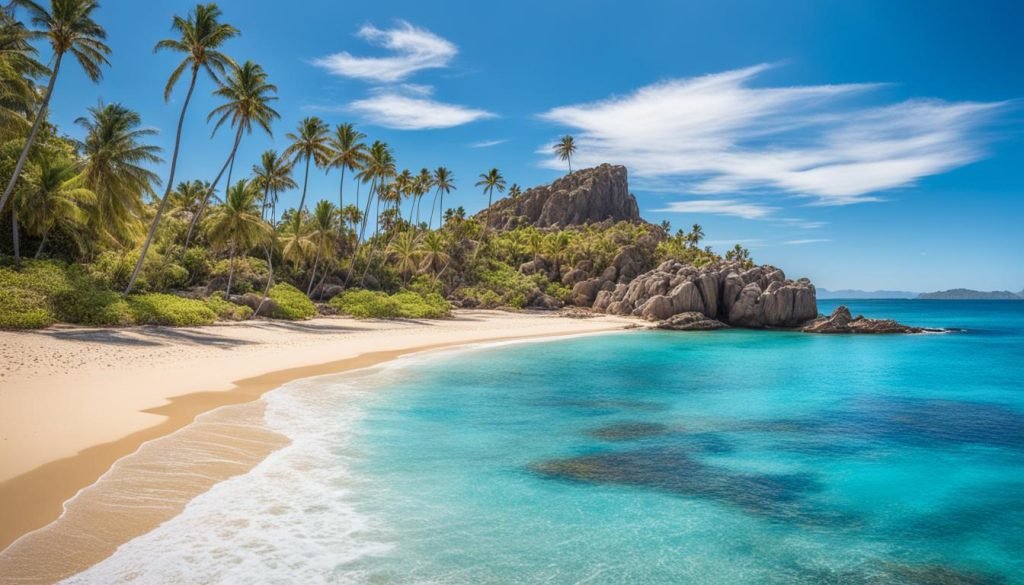 is about 1,148 kilometres long. It’s a big part of Tunisia’s charm. The coast has beautiful beaches and places for tourists. It also has important areas for fishing and valuable natural resources. This helps Tunisia in many ways.
is about 1,148 kilometres long. It’s a big part of Tunisia’s charm. The coast has beautiful beaches and places for tourists. It also has important areas for fishing and valuable natural resources. This helps Tunisia in many ways.
A quick look at Tunisia’s varied geography:
| Geographical Feature | Details |
|---|---|
| Mountain Ranges | Mostly Atlas Mountains, with peaks like Jebel ech Chambi and Jebel Boukornine |
| Major Plains and Valleys | Majardah River Valley, Sahel region famous for olives, and the Sahara Desert in the south |
| Coastline | 1,148 kilometres along the Mediterranean coast, known for tourism and important maritime claims |
The Capital of Tunisia: Tunis
The Tunisian capital, Tunis, is the heart where culture, politics, and economy meet. It’s the administrative centre of Tunisia. It paints a vivid picture of the nation’s rich history.
Tunis is famous for its old souks, Islamic buildings, and French past. The medina, a UNESCO site, lets you walk back in time. You’ll see old mosques and lively markets.
In Tunis, you’ll find big administrative places like the Bardo Museum and the president’s home. These spots show the city’s key role in Tunisia’s culture and politics.
Let’s look at some important things about Tunis:
| Aspect | Details |
|---|---|
| Historical Significance | UNESCO World Heritage Site with rich Islamic and colonial heritage |
| Economic Role | Primary economic hub with major markets and industries |
| Political Importance | Houses presidential palace and key administrative offices |
Tunis is more than just Tunisia’s capital. It beautifully mixes the past and the present. This city is key to Tunisia’s identity and its future growth.
Tunisia on the African Continent
Tunisia is at the top of Africa. It is a key entrance to North Africa. It is very special in Africa, especially in the North.
Tunisia has strong ties with nearby Arab-speaking countries. These include Algeria, Libya, Morocco, and Mauritania. They share history, culture, and business stuff.
Tunisia’s location makes it important in Africa. It’s been home to many cultures and trades. Its coastlines help it connect with Europe and others.
- Maghreb Integration: Tunisia is part of the African Maghreb. It shares its identity and culture with neighbours.
- Cultural Heritage: Many cultures like Phoenicians, Romans, Arabs, and French have influenced Tunisia. This has made its culture rich.
Tunisia is vital in Africa because of where it is. It has a rich heritage and is key in North Africa’s economy and society.
Understanding Tunisia’s Climate
The Tunisia climate is really interesting because of its location. It sits between the Mediterranean Sea and the Sahara desert. This means the climate changes a lot from north to south, making it a cool spot for people who study climate.
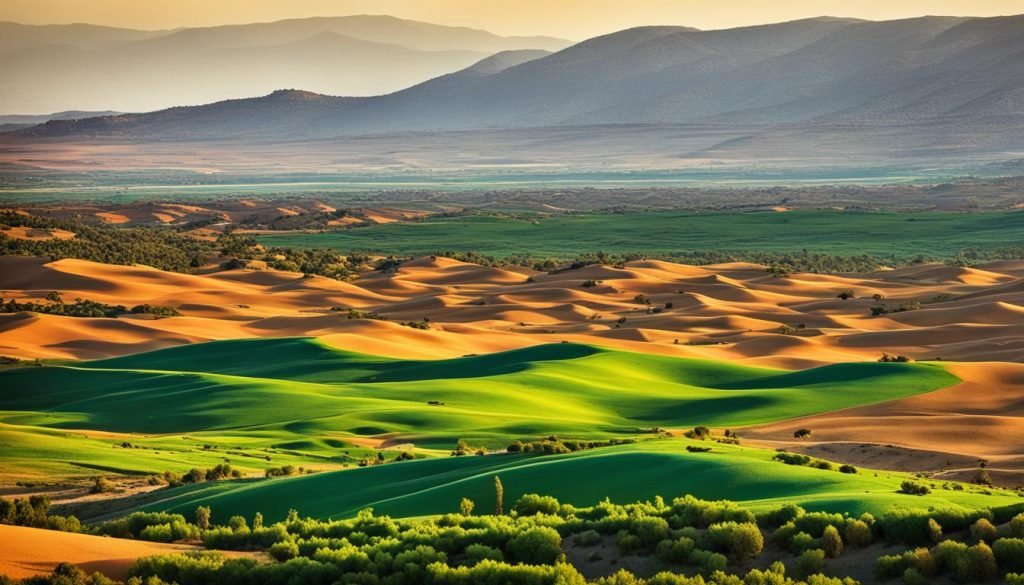
Mediterranean Influence
Up north, the Mediterranean weather keeps things mild in winter and hot in summer. Cities by the coast, like Tunis, have nice weather all year. This makes them great for visitors.
Semiarid and Desert Regions
But, as you go south, things change. The weather becomes drier and hotter, turning into desert. This area gets very little rain and can get very hot. The Sahara desert spreads into southern Tunisia, creating a dry place.
Temperature Extremes
The temperature in Tunisia can be very different depending on where you are. Near the coast, the sea helps keep the weather more steady. But, go inland or near the desert, and it gets much hotter in summer. In winter, it gets cooler. The sirocco winds from the Sahara can make it super hot and bring dust storms. These changes affect people’s lives and farming a lot.
Here’s how hot and cold it can get in different parts of Tunisia:
| Region | Summer Average (°C) | Winter Average (°C) |
|---|---|---|
| North Coast (Tunis) | 30 | 10 |
| Central Region (Sidi Bouzid) | 35 | 5 |
| Southern Desert (Kebili) | 40 | 0 |
Historical and Cultural Background
Tunisia’s past is like a beautiful story. It’s full of different chapters from various civilisations. These eras have left their unique marks, making Tunisia’s history truly special.
Carthaginian Heritage
The Carthaginian Empire is a big part of Tunisia’s past. This empire made the city of Carthage great. They were known for being great traders and sailors. The ruins of Carthage show us this past greatness.
Roman and Arab Influence
After Carthage fell, the Romans came. They built amazing buildings, like amphitheatres and aqueducts, that we can still see. Then the Arabs came in the 7th century. They brought in a new culture. This culture mixed well with the existing ones, making something very special.
Modern Development
Today, Tunisia is not just about its past. It’s growing in many ways. But it still remembers its rich history. The people of Tunisia honour their past. At the same time, they look forward to a bright future.
| Era | Key Influence | Notable Contributions |
|---|---|---|
| Carthaginian Empire | Trade and Naval Excellence | Ruins of Carthage |
| Roman Rule | Architectural Feats | Amphitheatres, Aqueducts |
| Arab Conquest | Islamic Culture | Blending Traditions |
| Modern Era | Economic and Social Development | Future-oriented Progress |

